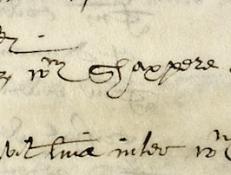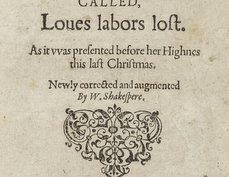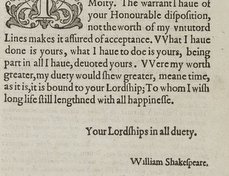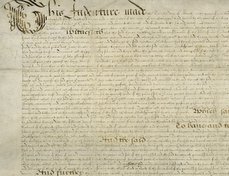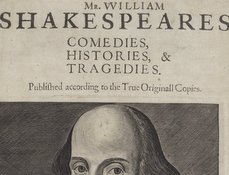Terms of use
The Bishop of Worcester has graciously contributed the above image from his collections to Shakespeare Documented, and retains sole ownership of said image. Visitors may link to and cite the image within Shakespeare Documented in personal research only. Any further use, including, but not limited to, unauthorized downloading or distribution of the image is strictly prohibited. Visitors must request permission from the Bishop of Worcester (care of The Registrar of the Diocese of Worcester, 8 Sansome Walk, Worcester, WR1 1LW, United Kingdom) for any additional use.
Document-specific information
Title: Shakespeare marriage bond
Date: November 28, 1582
Repository: The Diocese of Worcester, Worcester, UK
Call number and opening: x 797 BA 2783
Robert Bearman, "The Shakespeare marriage bond," Shakespeare Documented, https://doi.org/10.37078/679.
Diocese of Worcester, x 797 BA 2783. See Shakespeare Documented, https://doi.org/10.37078/679.
This marriage bond, dated November 28, 1582 states that there was nothing to prevent William Shakespeare and Anne Hathaway’s marriage from taking place, and that the bishop of Worcester, who issued the marriage license would be safeguarded from any future possible objections.
It is one of two documents recording the marriage of William Shakespeare and Anne Hathaway, but the evidence is flawed. An entry, dated the day before this bond on November 27, 1582, in the bishop of Worcester’s register records that a license was granted to William Shakespeare for his marriage to Anne Whateley of Temple Grafton, while this bond names the parties as William Shakespeare and Anne Hathaway of Stratford-upon-Avon.
The marriage bond is only one of three documents which might have been produced to secure the license (now lost) and, of the three, is from the biographer’s standpoint the least informative. However, it is an original document and thus more likely to be more accurate than the register entry, which is a later copy.
An allegation would have initiated the proceedings. For the diocese of Worcester, no allegations earlier than 1661 survive. However, other extant allegations from this earlier period indicate that the document would likely have named the parties, their parents or guardians, and an explanation as to why a license was required and why the marriage was to take place in a parish which was neither the bride’s nor the groom’s. The allegation might have been supplemented by an equally informative certificate from a person known to both parties that there were no obstacles to the marriage. A bond was then drawn up in formulaic terms based largely on the information received from the previous two documents, offering some insurance to the bishop if it was later found that the license should not have been issued. Despite the lack of personal data which the allegation would have contained, the bond therefore became a more important document to file. Bonds preserved in this way by the bishop of Worcester’s officials are still largely extant, including the one which guaranteed the issue of a license for Shakespeare’s marriage to Anne Hathaway.
In the Worcester diocese around this time, a bond required that two relations, guardians or friends of the couple, acting as sureties, bound themselves in £40 that certain conditions, normally four, had been, or would be, met. The conditions were: firstly, that there was no obstacle to the marriage; secondly, that there was no legal process pending concerning it; thirdly, that the groom should not proceed with the marriage without the consent of the bride’s friends or relations; and fourthly, that the groom should save the bishop harmless from any challenges to the marriage which might arise thereafter. William and Anne’s bond contained all four conditions as did fifty-five other Worcester bonds (out of seventy-five issued that year) thus making it one of a substantial majority.
However, there is a significant difference in the names of the sureties. Normally the groom would stand as one of the sureties, but since William was under age, that was not possible. The other surety was often a relative of the bride, often the father, but Anne’s father was dead. In such circumstances, it might have been expected that John Shakespeare would have stepped forward on behalf of his son, but he did not. This may not have been significant, however, as in the remaining 1582 bonds there are no cases of a man of the same family name offering his services when the groom did not act as surety. In Anne’s case, a close family member might still have stood surety in default of a living father, but again this did not happen. Instead the sureties were named as Fulk Sandells and John Richardson, each described as an agricola, or farmer, of Stratford. There is nothing inherently surprising about the involvement of these two men. A few months earlier, in June 1582, Richard Hathaway described Sandells and Richardson as “my trustie frende and neighbours” when he appointed them supervisors of his will. However, it did mean that the bondsmen acting on the couple’s behalf could, in the bond’s third condition, only be described as “friends.” There were only seven similar instances in the seventy-five bonds filed in 1582. Again, given the circumstances, this may not have been of significance but at the very least it does indicate that no Shakespeare or Hathaway family member either chose, or was asked, to act as guarantor.
Written by Robert Bearman
Last updated January 25, 2020


